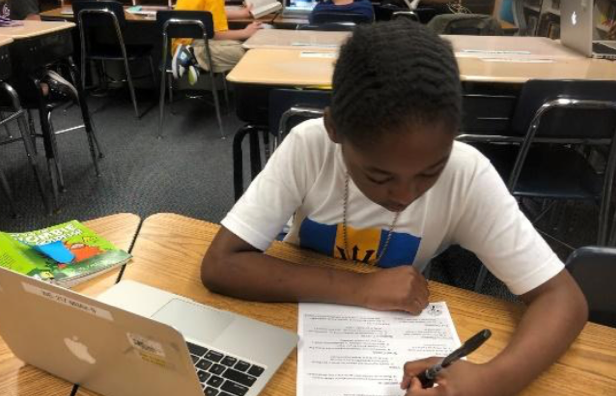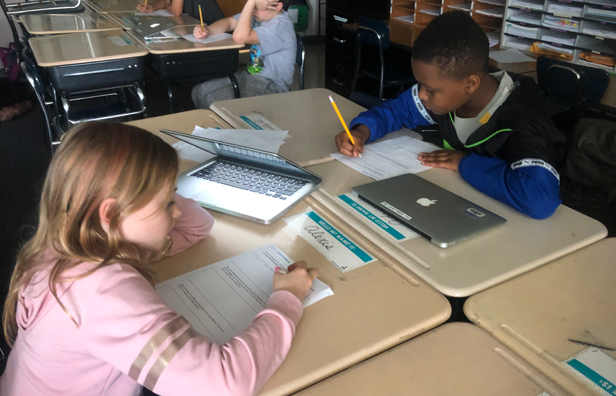
Can students help create a class full of millionaires?
Each year, millions of people are crushed by the burden of debt. Millions more are empowered by the miracle of savings and investment. In this project, students will learn the essentials of financial literacy—and use those skills for good by getting high school students “interested” in making smart financial decisions. Watch as your students form meaningful relationships while coaching teens on important money management skills.
Imagine if kids could help themselves and others make smart financial decisions. The skills they learn today could build solid habits to last a lifetime!



What’s included in your project?
Cross-Curricular Content
Every Blue Apple project provides suggested content correlations to Common Core State Standards, Next Generation Science Standards, and C3 Framework for Social Studies. A featured mini-lesson from each content area is highlighted below along with additional lesson ideas. Not teaching these standards? No problem! Check out the 50 Years of Interest K-8 content correlation document for additional lesson ideas.

Math
Division with Decimals
Lesson 3: As students play the “Money Multiplies,” game, help them gain deeper understanding and fluency with fractions as they apply their learning to complete the game. CCSS.MATH.CONTENT.5.NBT.B.7Understanding Fractions
Lesson 3: During your play of the “Money Multiplies” game, explore why one-sixth of a number is the same as dividing the number by six, and connect your discussion to the idea that a/b is the same as a ÷ b. CCSS.MATH.CONTENT.5.NF.B.3Interpreting Graphs
Lesson 4: On slides 10-12 of the Risky Business slideshow, have students reflect on and discuss the effect of changing the scale of the axis, as well as on the story told by each of the graphs. When did the investment increase and decrease in value? By a lot or a little? CCSS.MATH.CONTENT.5.G.A.2Line Plots
Lesson 8: Have students evaluate a group’s lesson on a five-star scale. Allow students to give half- and quarter-stars, and construct a line plot of the votes. CCSS.MATH.CONTENT.5.MD.B.2

English Language Arts
Integrating Ideas
Lesson 4: Read, The Kid’s Guide to Money, by Steve Otfinoski. Compare and contrast the information presented with the information in the Risky Business slideshow. CCSS.ELA-LITERACY.RI.5.7Opinion Writing
Lesson 5: Prepare to teach older students about financial literacy by learning more about the art of persuasion. Teach students about reason and evidence, as well as about considering your audience. As students construct their lessons, have them reflect on the lessons they’ve learned to make a compelling case. CCSS.ELA-LITERACY.W.5.1Publishing with Technology
Lesson 9: Have students turn their lessons into a book, and publish it using a platform such as Kindle Direct Publishing, CreateSpace, or Book Baby. CCSS.ELA-LITERACY.W.5.10Collaboration
All Lessons: Throughout the project, have students engage in a range of collaborative discussions to express ideas and build upon the ideas of others. CCSS.ELA-LITERACY.SL.5.1

Science
Physical and Chemical Changes
Lesson 1: After producing the reaction with your Elephant Toothpaste demonstration, explain that this wild and uncontrollable reaction is called a chemical change. Discuss the characteristics of chemical changes, and explore other chemical reactions that students are familiar with. NGSS 5-PS1-4Conservation of Matter
Lesson 1: In your Elephant Toothpaste demonstration, conduct the experiment inside a large, clear plastic tote. Weigh the container before and after the experiment to demonstrate that although a chemical change occured, matter was neither created nor destroyed. NGSS 5-PS1-2Movement of Matter through Ecosystems
Lesson 4: Connect the movement of money through the financial system (producers, consumers, etc) to the movement of matter through an ecological system (plants, animals, decomposers). NGSS 5-LS2-1Constraints
All Lessons: Throughout the project, discuss with students how they are operating within constraints. They are limited by their materials and the amount of time they have. NGSS 3-5-ETS1-1

Social Studies
Economic Interdependence
Lesson 2: When considering delayed gratification, discuss different incentives that might be used to encourage responsible behavior. NCSS D2.ECO.15.3-5Interest Rates
Lesson 2: Discuss what interest rates are, and show how they affect the growth in the cost of the donut. NCSS D2.ECO.10.3-5Collaborative Action
Lesson 4: As you learn about mutual funds, use the opportunity to help students understand the power of collaborative action. NCSS D2.CIV.6.3-5Costs and Benefits
Lesson 4: Compare the benefits and costs of individual choices as you analyze the outcomes of different investment strategies. NCSS D2.ECO.1.3-5

Social Emotional Learning
- Self-management and Responsible Decision-making
Lesson 2: Teach the importance of self-management and responsible decision-making by discussing the Marshmallow Challenge. Help students develop self-management skills, as well as the ability to make responsible decisions, by teaching them specific metacognitive strategies to promote delayed gratification.
Not teaching these standards?
No problem! Check out the 50 Years of Interest K-8 content correlation document for additional lesson ideas.
Each Blue Apple Project Includes:

- Engaging lessons designed to make learning memorable, meaningful, and fun
- Curated online resources to save you time searching for content
- In-person, virtual, and hybrid options for all learning environments
- Cross-curricular mini-lessons in English-Language Arts, Math, Science, Social Studies, and Social-Emotional Learning
- Videos and contact info provided by real-world experts willing to meet with your students
- Opportunities to collaborate with other classrooms doing the same project
- Free project supplies to get you started right away


